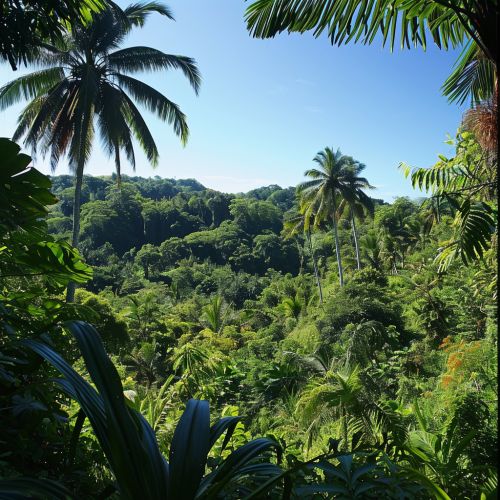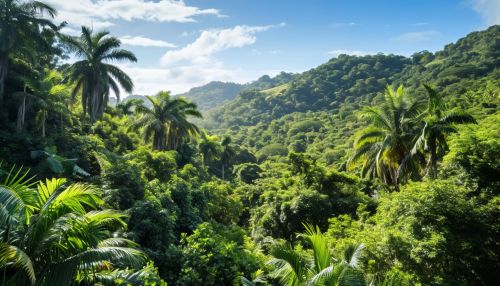Tropical climate
Introduction
A tropical climate is a type of climate typical of the tropics, a region of the Earth located roughly within the Tropic of Cancer in the northern hemisphere and the Tropic of Capricorn in the southern hemisphere. These climates are characterized by high temperatures throughout the year, with minimal temperature variation between seasons.
Characteristics
Tropical climates are generally characterized by high temperatures, with the monthly mean temperature rarely falling below 18 degrees Celsius (64 degrees Fahrenheit). The annual temperature range in tropical climates is typically very small, often less than 3 degrees Celsius (5.4 degrees Fahrenheit).


The high temperatures in tropical climates are due to the Earth's tilt on its axis and its elliptical orbit around the sun. This results in the sun being overhead at least once during the year at all points within the tropics, leading to high solar insolation and consequently high temperatures.
Tropical climates also typically have high humidity, due to the high temperatures leading to high rates of evaporation. This high humidity can make the heat feel more intense and can also lead to high levels of precipitation.
Classification
There are several different types of tropical climates, classified based on patterns of precipitation and temperature. The Köppen climate classification system, developed by German climatologist Wladimir Köppen, is the most widely used system for classifying tropical climates.
Tropical Rainforest Climate
The tropical rainforest climate, also known as an equatorial climate, is characterized by heavy rainfall throughout the year, with annual precipitation often exceeding 2000 mm. This climate is typically found in lowland areas near the equator. The Amazon Rainforest in South America and the Congo Rainforest in Africa are examples of regions with a tropical rainforest climate.
Tropical Monsoon Climate
The tropical monsoon climate is characterized by a short dry season and a prolonged wet season. The dry season in this climate is typically less than two months long. This climate is most commonly found in South and Southeast Asia, including parts of India, Bangladesh, and Myanmar.
Tropical Savanna Climate
The tropical savanna climate, also known as a tropical wet and dry climate, is characterized by a distinct wet season and dry season. The dry season in this climate can last for several months. This climate is most commonly found in regions bordering tropical rainforest climates, including parts of Africa, South America, and Australia.
Impact on Biodiversity
Tropical climates are home to a significant proportion of the world's biodiversity. The high temperatures and rainfall in these climates create ideal conditions for the growth of plants, which in turn support a diverse range of animal species.
Tropical rainforests, in particular, are known for their high biodiversity. These ecosystems are home to an estimated 50% of all terrestrial species, despite covering less than 2% of the Earth's surface.
Human Adaptation
Human societies have adapted to tropical climates in various ways. Traditional societies in these climates have often developed subsistence strategies based on the abundant natural resources available, such as hunting and gathering, fishing, and slash-and-burn agriculture.
In modern times, tropical climates have become important regions for agriculture, particularly for the cultivation of crops such as rice, sugar cane, and various tropical fruits. However, these climates also pose challenges for human habitation, including high heat and humidity, heavy rainfall, and a high prevalence of tropical diseases.
